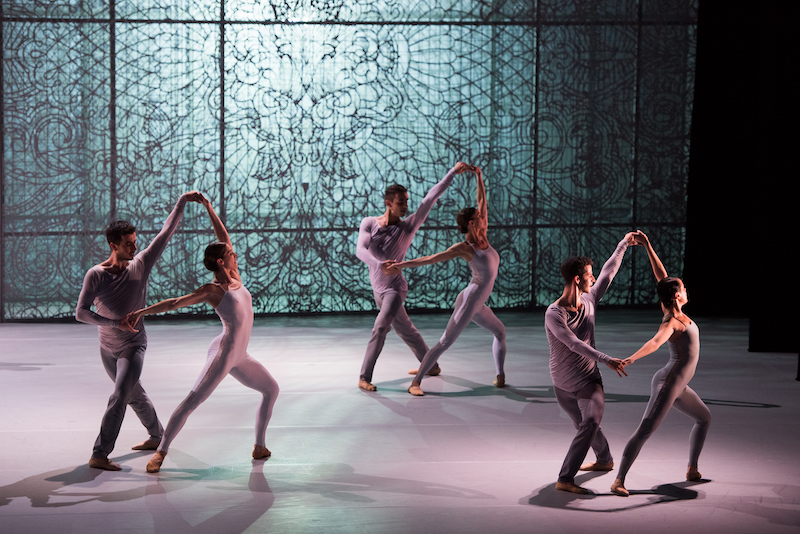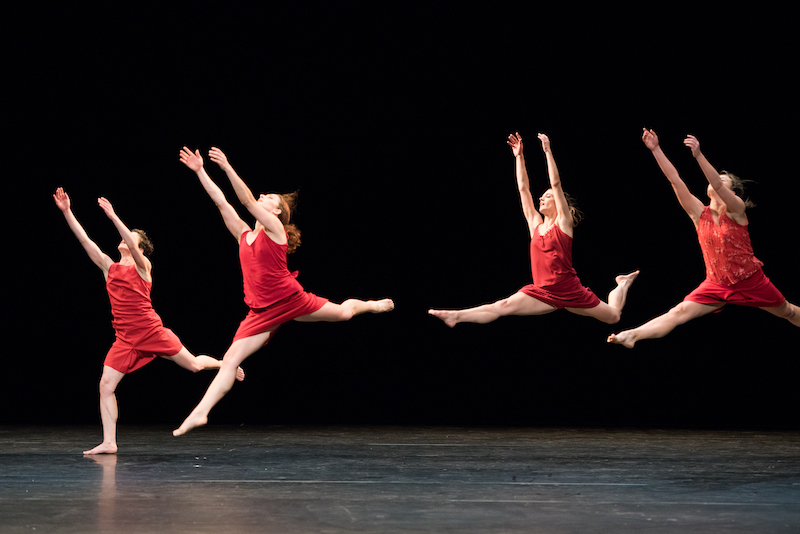Beethoven’s Grosse Fuge, the final movement of his Quartet No. 13 in B-flat major, has long divided opinion. Written when he was profoundly deaf, the double fugue is known for its unrelenting intensity and occupation of the extremes. Composer and violinist Louis Spohr once described it as “an indecipherable, uncorrected horror,” while Stravinsky predicted it would remain forever contemporary.
In Trois Grandes Fugues, a triple bill of dance performed by the Lyon Opera Ballet, this plurality of opinion is not the problem, but the answer. Three different interpretations of the infamous fugue by three leading female choreographers have been curated into a single evening program. It’s a thrilling series that illuminates the genius of both composer and choreographer; where equally sophisticated systems are expressed via different mediums.
 Lucinda Childs’ Grande Fugue. Photograph © Bertrand Stofleth
Lucinda Childs’ Grande Fugue. Photograph © Bertrand Stofleth
American choreographer Lucinda Childs opens the evening with her “sparse ballet” for six couples dressed in grey, originally created in 2016. The movement – which is classically academic, littered with arabesques and sissonnes along strong diagonal lines – unfolds in short looped phrases. This mirrors the subject of Beethoven’s fugue, which, like the dancing, is repeated with progressive variations.
Accumulation and adherence to rules are just two of Childs’ postmodern tools that pair nicely with the rigidity of the fugal structure. Repetition is also key; the same material looped over and over. The layering of movement, typical of Childs’ work (and that of her Judson Church contemporaries), creates a tidal effect, revealing the spectacle over time.
It also allows us to see the increasing effort needed to execute each repeated movement. Although the academic form became a little too exposing for the dancers towards the end of the work, the attempt offered a compelling physical embodiment of Beethoven’s fervour.
The second work is a 1992 interpretation by Belgian choreographer Anne Teresa De Keersmaeker. Framed by two long planks of blonde wood and rows of hanging lights, an ensemble of eight dressed in suits conjure a whirlwind of fantastic dancing.
Again, there is a base phrase from which deviations and flourishes erupt. Over and over, the dancers collapse into a roll along the floor then spring to their feet with renewed vigour. It’s an effortless loop bookended by Jerome Robbins-tucked jumps, rapid off-kilter turns and low American swings.
The dancers circle around the edges of the space, breaking off into solos, duets, trios, etc, to interrupt each other’s phrases or sync into unison. The phrases envelope and penetrate each other at breakneck speed, teasing the audience to keep up.
De Keersmaeker’s choreography is supremely clever. It allows us to hear (and see) details in the music that most untrained ears can’t detect. The dancers, too, deftly balance precision with abandonment, carrying the audience with them on the sonic rollercoaster.
 Maguy Marin’s Grosse Fugue. Photograph © Bertrand Stofleth
Maguy Marin’s Grosse Fugue. Photograph © Bertrand Stofleth
Completing the program is French choreographer Maguy Marin’s 2001 iteration for four women. Dressed in red tops and skirts, the dancers burst on stage to declare their presence as the four voices of the quartet.
Beethoven’s Grosse Fuge opens with nearly five minutes of continuous fortissimo music – the loudest dynamic – and this intensity is palpable in Marin’s opening sequence. Heads are tossed back, fists are swung, legs leap and gallop. The women seem to derive their energy from the earth; from each other; from Beethoven.
Although loose in form, the work is no less technical or precise in its physical demands or composition. The choreography is richly detailed, giving the women each a separate voice but uniting them in rhythm. As the work builds, exhaustion appears, but not a sense of defeat. The dancers match the intensity of the score, as if their own quartet of bodies were producing the sound.
There are structural similarities to be found across all three works, but vast tonal differences. Reading Beethoven’s music through the bodies of the Lyon Opera Ballet’s talented and compelling performers is exhilarating and invites a new appreciation for the marriage of music and dance.











Comments
Log in to join the conversation.